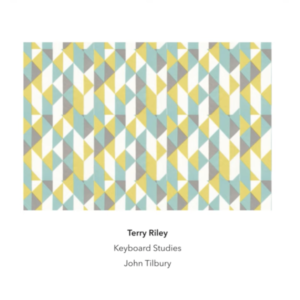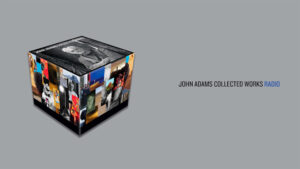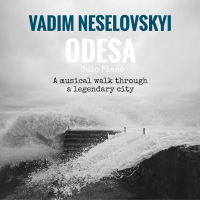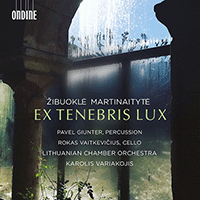William Bolcom – The Complete Rags
Marc-André Hamelin
Hyperion Records
William Bolcom has been an important exponent of the ragtime revival. He helped to mount Scott Joplin’s ragtime opera Treemonisha, has performed Joplin and much of the ragtime repertoire. Bolcom may have had a hand in Joshua Rifkin’s famed Joplin recordings, which were used in the movie The Sting. As Bolcom tells it, he played Rifkin rags by Joplin at a party before the recording was made. Bolcom also encouraged contemporary American composers to return to ragtime, trading many rags with composer William Albright (one of the pieces on this recording is a collaboration between them), and performing the rags written by a number of others, mainly during the 1970s. His own catalog of rags is considerable, and considerably varied.
Joplin’s sheet music often included the admonition, “do not play fast,” instead urging a deliberate pace. Bolcom takes this to heart, and pianist Marc-André Hamelin, the interpreter on this recording, pays studious attention to the details of tempo and phrasing that define ragtime. Like most classic rags, Bolcom uses titles that hearken back to ragtime progenitors past (“Eubie’s Luckey Day,” “Seabiscuit’s Rag”), give a sense of character and gesture (“Tabby Cat Walk,” “Rag-Tango”), or are punnish (“Brooklyn Dodge”).
Many of Bolcom’s rags are suavely stylish, such as the well-titled “Contentment” and “Tabby Cat Walk.” Of course, not fast is not ubiquitous. In a set of rags titled “Eden,” the third, “The Serpent’s Kiss,” is rollicking, “girl on the railroad tracks” music with a taste of silent film accompaniment. The Allbright-Bolcoe collaboration, “Brass Knuckles,” avails itself of splashes of dissonance, recalling Nancarrow and Monk through a Joplin lens. In “Rag-Tango” and “Estela – Rag Latino,” other genres are successfully amalgamated into ragtime. It is difficult to pick favorites, but I’m partial to “Three Ghost Rags,” in which music of times past is echoed. Hamelin plays this group with particular sensitivity.
Like Joplin’s rags in the 1970s, Bolcom’s in the 2020’s deserve wider currency. Some are quite difficult, requiring the chops of a pianist of Hamelin’s caliber. Others would be excellent pieces for competitions or study. The liner notes, with an essay by Bolcom, give an erudite, encapsulated view of classical rags and contemporary contributions. Highly recommended.
-Christian Carey

Cold Blue Music has released Houses of the Wind, a new album of electro-acoustic music by Pulitzer Prize-winning composer John Luther Adams. This was inspired by a 1989 recording of Alaskan arctic winds blowing through an aeolian harp. In listening to that original recording again, John Luther Adams writes: “The voices of the wind singing through the strings of the harp brought back vividly the clarity of light, the sprawling space, and the sense of possibility I had felt.” The recent pandemic lock down presented Adams with the studio time to electronically reshape the recording and the result is a five-movement piece consisting of variations on the same ten-and-a-half minute original. This was accomplished using voice layering, time stretching and pitch manipulation to fashion continuously changing patterns and textures of sound, as animated by the wind itself. Houses of the Wind is both a distillation and summation of the strong environmental influences present over the entire arc of Adams musical career.
All of the movements share the same general character – there are no formal rhythms or structures; the composer uses variations in the mix of pitches and changes in their intensity to express patterns in the wind. The overall effect is a wash of tones that change character relatively slowly and possess an organic sensibility that evokes the natural atmospheric phenomena. Each movement describes a separate category of wind. For example, the title of the first movement, Catabatic Wind, refers to a wind that carries high-density air from a higher elevation down a sloping terrain under the force of gravity. In Southern California, we have the Santa Ana winds, flowing from the high deserts down to the coast, and this is a catabatic wind. Accordingly, the first movement begins with high, brightly metallic tones, piercing and penetrating to the ear as the volume builds. The intensity suggests a bright, clear arctic day on a high plateau. The sounds swell and crest as the mix of pitches vary, gradually adding tones in the middle and lower registers as if describing a wind that is running ‘downhill’. About halfway through, the volume and intensity subside and there is a more reflective character as the piece quiets down, with middle and lower pitches predominating. Throughout the album, Arctic nature is invariably characterized as a positive force. Catabatic Wind, starts out forcefully and is generally one long decrescendo, unfolding with a regal impartially.
Mountain Wind follows and as might be expected, this movement is less settled. Beginning with low, softly droning sounds that gradually increase in volume, there is a sense of expectation as higher pitches are added and then fall away. These cycles continue, varying in duration and intensity with the middle and higher pitches spiking in volume – a metaphorical gusting of winds in the mountain passes. The sounds reach ever higher in pitch and volume – almost to the point of pain – recalling the sharp bite of the wind in an arctic mountain blast. There is also a mystical element to this movement that befits the imagined mountain scenery. Towards the finish the tones subside, becoming more distant and the pitch content becomes lower as the sounds get softer. At length, we are returned to the low drone of the opening. Mountain Wind artfully portrays the changing wind movements typical in mountainous terrain.
The middle movements, Tundra Wind and Canyon Wind capture the differing characteristics of the wind in these environments. Tundra Wind contains a mix of higher register pitches and a pulsing that evokes a swirling wind on an open landscape. The pitches seem more varied and active in this, giving a strong sense of motion. This is perhaps the most open and welcoming movement, a bit nostalgic, but never grim or angry. The intensity rises and falls as winds will do in an open space – a very beautiful portrayal. Canyon Wind provides a contrast, opening with high pitches that are brilliantly loud and hard on the ears. With lower pitches in between, the bursts of higher tones suggest the gusting of wind in a narrow canyon. About halfway through, there is a quiet lull, followed by the entrance of middle pitches that indicate a building breeze. This increases in volume and rises in pitch, but blows steadily without gusting before fading at the finish.
The final movement is Anabatic Wind, and this refers to a gentle wind blowing up slope due to the sun heating the surface of the ground. This movement opens with a low hum, quietly pulsing to create a feeling of solemnity. New pitches enter from the middle registers, not in force, but just enough to lighten the deep tones below. Additional higher pitches enter, swell up briefly, and then subside again as if in no hurry. The feeling becomes more optimistic with the added entry of these new pitches, less gloomy and ultimately bright enough to suggest a brilliant sun above. By 6:30 higher pitches dominate making for a harder sound, always increasing. The overall feeling, however, is a mix of the urgent and the settled; Anabatic Wind never seems aggressive or dangerous. In contrast to Catabatic Wind, the first movement, the gradual, continuous crescendo heard in Anabatic Wind is the reverse of the catabatic process, and makes a fine book-end to complete Houses of the Wind.
That five variations on the same original recording can be so distinctive while exhibiting the same general form is a tribute to the artful manipulation by Adams of density, volume and pitch within a limited context. This adds to the elemental feel of the piece and allows the wind to portray itself through the original recording. The direct articulation of wind into sound through the medium of the aeolian harp makes Houses of the Wind a unique convergence of music, emotion and nature.
Houses of the Wind is available from Cold Blue Music directly as well as from numerous CD retailers.
James Romig
The Complexity of Distance
Mike Scheidt, electric guitar
New World Records
James Romig is best known for his solo piano piece Still, an hour long meditation on the paintings of Clyfford Still. Trained at Iowa and obtaining the Ph.D. at Rutgers, where he worked with Charles Wuorinen and Milton Babbitt, Romig has a number of serial works to his name. The structuring of Still displays this, but the surface has a limpid character and the gradual development of the material also demonstrates an affinity for Morton Feldman and Earle Brown. Pianist Ashlee Mack’s recording of Still was a finalist for the Pulitzer Prize, an unusual choice for the committee, as large-scale works – opera, orchestral pieces – are more often selected.
Romig’s current project is an even greater departure. The Complexity of Distance is for solo electric guitar, tuned down a fifth so that the low string is A instead of E. It was commissioned by doom metal guitarist Mike Scheidt and composed during the remote times of the pandemic via long distance communication. Scheidt is best known as being part of the band YOB, but he adapts well to the detailed notation and solo context of TCOD.
The piece opens with a sustained open power chord, which forms the basis of the piece: roots, fifths, and octaves, seldom thirds. TCOD’s rhythmic structure is a three-line canon, which Romig describes thus,”The first rhythmic strand alternates, at a time-interval of 13 beats, between chords with roots written E and G (sounding A and C in A-standard tuning). The second strand alternates every 14 beats between chords with roots of C and D (F/G). The third strand alternates every 15 beats between chords of B and A (E/D).Beginning and ending with a unison pulse in all three strands, the 13:14:15 ratio takes 2,730 beats to resolve. At a metronome tempo of 48, this cyclic process lasts nearly an hour.”
The canonic techniques that Romig is using have ample precedents, from Ockeghem and Josquin in the Renaissance, to Conlon Nancarrow’s player piano pieces in the twentieth century, and Babbitt, Carter, and Wuorinen’s use of time points and canonic devices in their post-tonal pieces. The overarching structure requires patience to apprehend, but it is a well-conceived use of rhythmic design. On the death metal side of the equation, the power chords use feedback and distortion and sustain through the score’s rests. Many of the chords employ open strings for resonance. Scheidt’s choice to tune down allows the piece to co-opt the sonic signatures of doom metal, its sepulchral register and slow tempos.
TCOD is a curious amalgam. It stretches the stylistic possibilities in which one may incorporate complex canons and serial procedures. A departure for Romig to be sure, but a winning one.
-Christian Carey
Terry Riley
Keyboard Studies
John Tilbury, piano, harpsichord, celeste, and electric organ
Another Timbre
In addition to their impressive catalog of music of the moment, the past recordings that are uncovered and released by Another Timbre are frequently astonishing. This is certainly true of a recording of the great new music keyboardist John Tilbury playing three pieces by Terry Riley from 1965: Keyboard Study No. 1, Keyboard Study No. 2, and Dorian Reeds. Written just after In C, these pieces are foundational as well, presenting the methods with which Riley would assemble solo work from patternings. Like In C, they do not have full scores, and their durations may vary. Dorian Reeds was originally written for saxophone with tape delay and is adapted here for electric organ. Tilbury is well known for his performance of New York School composers, Morton Feldman in particular, as well as his work as a free improviser. This is the first recording of him engaging with 1960s American minimalism.
The tapes from which this CD was made are from the late 1970s or early 1980s in Hamburg, with other details forgotten. They have weathered well, and provide an important link to that time period, in which American minimalism had begun to have a significant number of British and European interpreters. The 1980s would see minimalism capture English composers’ interest as well, with figures like Michael Nyman and Steve Martland creating distinctive repetition-based music.
Tilbury’s performance of Keyboard Study No. 1, played on the piano, clocks in at eighteen minutes. Like In C, a repeated pitch is a constant throughout. The piece features unraveling and returning patterns not dissimilar to Steve Reich’s phase pieces, with tasty secundal dissonances set against fourths and fifths and generally avoiding thirds. Gradually, it moves through all sorts of modal inflections and polyrhythms.
Keyboard Study No. 2 has the most elaborate instrumentation: piano, electric organ, harpsichord, and celeste. Over a half hour long, it is also the most expansive. Once again, scales and rhythms morph against a constantly repeating note. Here, the instrumentation brings out different parts of the patterning, the varied attack and sustain of the instruments allowing notes to become prominent or recede in the texture.
Dorian Reeds works well for organ, with intervallic oscillations and corruscating melodic gestures punctuated by repeated pitches. The organ registrations provide varied timbres for the piece’s motives, with more and more lines accumulating as the piece develops. Tilbury plays Dorian Reeds with tremendous dexterity. Here, as elsewhere, he delineates the counterpoint with deft touch. The original saxophone version is compelling, but this version is equally so. Recommended.
-Christian Carey
John Adams
Collected Works Boxed Set
40XCDs
Nonesuch
What a seventy-fifth birthday present. Today, Nonesuch releases John Adams Collected Works, a 40-CD compendium of his recordings for the label and a few from other imprints.
The curation of the set has thoughtful touches. It begins with Harmonielehre, the 1985 recording by Edo de Waart that began Adams’s association with Nonesuch and ends with a live recording of the same work by the Berlin Philharmonic, which released its own Adams boxed set a few years back (well worth seeking out). There are extensive liner notes, with essays by Timo Andres, Nico Muhly, Jake Wilder-Smith, Julia Bullock, and Robert Hurwitz.
Adams continues his creativity apace. Accordingly, space has been left in the box for future recordings.
From 12:00 PM to 12 AM (EDT), listen to excerpts from the boxed set here.
Tonight, June 28, 2022, the Chelsea Music Festival in New York City brings their annual festival to a close. The theme of the festival is, “Not Without You,” and the culminating chamber program features music by siblings Felix and Fanny Mendelssohn.
An intriguing addition to the programming is two works by the British composer Edmund Finnis: Brother and Sister. Even more intriguing is the fact that two actual sisters – violinist Lisa Lee and cellist Angela Lee, will be performing the string duo by Finnis, Sister. Fun fact: Radiohead’s guitarist Jonny Greenwood is a fan of Edmund Finnis, and included a recording of Brothers on an album he curated for NOMAD records.
More treats on the program: the Ulysses Quartet performs Felix’s Quartet in F Minor; and some of the personal correspondence between Fanny and Felix will be shared. Details at https://www.chelseamusicfestival.org/2022events/finale
Vadim Neselovskyi
Odesa
Sunnyside Records
Jazz pianist Vadim Neselovskyi was born in Ukraine. He moved to the US to study at Berklee and has since joined its faculty, splitting his time between New York, Boston, and as a touring musician. His latest recording for Sunnyside, Odesa (the Ukrainian spelling of the city’s name) is a memory book of Neselovskyi’s childhood in Ukraine, with various places and experiences recounted as programmatic elements of the music. Another layer of the recording’s organization is the use of Pictures at an Exhibition, by Russian composer Modest Mussorgsky, its character as a suite of images that one encounters walking through a museum, as a kind of touchstone for the scenes Neselovskyi has depicted. Accordingly, he subtitles Odesa, “A musical walk through a legendary city.” There are several places where Neselovskyi slyly interpolates brief flashes of Mussorgsky’s music; one will hear a particularly vivid quote at the end of track two, “Odesa Railway Station.”
Classical music frequently informs Neselovskyi’s playing. He is a double-threat pianist, one able to channel and play concert music while at the same time possessing sturdy jazz chops and improvisational acumen. On “Potemkin Stairs,” there are flurries of ostinatos, calling to mind both minimalism and the passagework of Romantic concertos. These are interspersed with plummy chordal passages that halt the piece’s momentum to savor a rich harmonic language. Where “Potemkin Stairs” is virtuosic, “Winter in Odesa” seems based on Eastern European folk music, with a concomitant Impressionist cast. Here Neselovskyi builds a moving piece out of a simple modal tune and countermelodies. Over time, elaborate ornaments are added to the middle section, only to return to the modal tune with a fourths and fifths harmonic accompaniment: another signature of folk music.
Neselovskyi had distinguished studies and an early acceptance at Odesa Conservatory. This is celebrated by “Waltz of Odesa Conservatory,” which depicts a mischievous youth playing with humorous, showy, and then jazzy gestures. One can imagine young Neselovskyi far away from his teachers when playing in this manner. The waltz is great fun: one could imagine a notated version serving as a competition piece. “My First Rock Concert” is the only composition on Odesa that isn’t an original. It is based on the rock song “Blood Type” by Viktor Tsoy. The voicings remind one of how barre chords are played on the electric guitar, with lots of parallelisms. Playing this alongside the vocal melody, bass part, and inflections of the percussion is no mean feat, and it stretches out with proggy soloistic sections to eight minutes in duration (now I want to check out some Viktor Tsoy: Neselovskyi makes him sound compelling).
Two interludes serve as etudes for modern jazz styles, the first atmospheric and the second angular. “Acacia Trees” inhabits a hushed wayward melody and aching, poignant harmonies. The opening line of “Odesa 1941” delicate too, but it is accompanied by a thrumming, sustained bass pedal and succeeded shortly by dissonance verticals and a polymetric dance and a thunderous middle cadence. It is like a tempestuous amalgam of works by Bartôk and Shostakovich. At the piece’s conclusion, the gentle opening melody returns, basically unaccompanied. Thus, the entire dynamic and rhetorical spectrum is accommodated in just under six minutes. Supplied with a brief Phrygian introduction filled with open fourths/fifths, “Jewish Dance” depicts another aspect of Neselovskyi’s background. The dance proper has a soprano register tune that glides downward through a minor scale with a flat second, a feature of both Jewish and Eastern European music. The tune reverses direction, rising against countermelodies and thick quartal/quintal bass register chords. The two melodies, now in soprano and alto registers, are juxtaposed and one is augmented, creating a long, pedal-supported cadenza. The last section of the piece brings its register down about an octave, thickening the accompaniment and adding a slice of swing to the polymeter. It moves into half-time, then double-time, and ends with another descending cadenza and a pedaled splash of color.
“The Renaissance of Odesa” concludes the recording. A haunting midrange melody against harmonically intricate arpeggiations, that lead the tune through a number of key areas, occupies a registration previously unheard on the recording. But two flourishes at the end once again evoke Mussorgsky: low bass fifths and octaves and an altissimo register modal duet. It is as if Neselovskyi is saying goodbye, for now, to his past and to all its treasured reference points. Odesa is imaginative, superlatively well performed, and enthusiastically recommended.
(All proceeds from the recording go to humanitarian efforts in Ukraine).
-Christian Carey
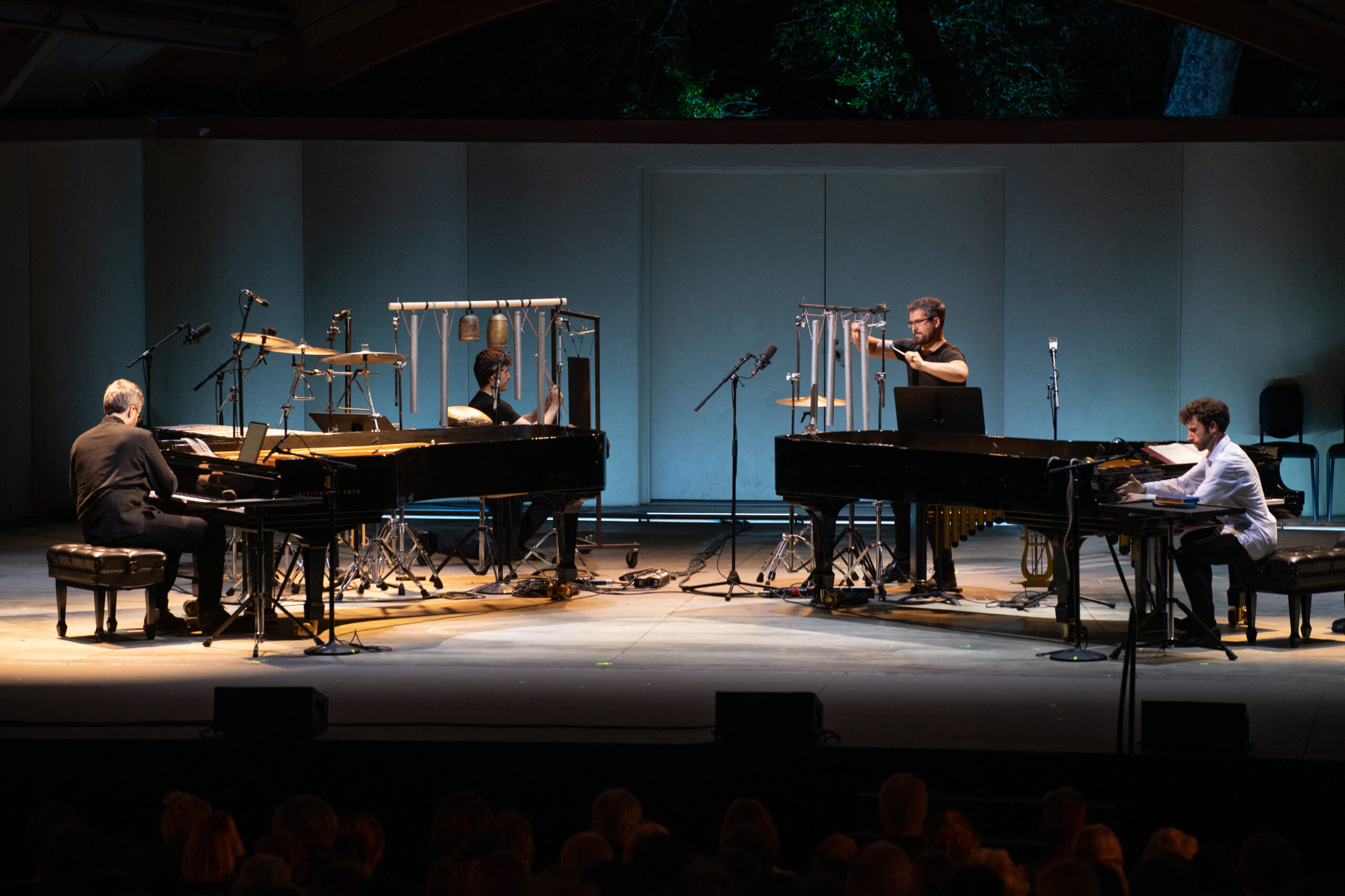
On Saturday, June11, 2022 the Ojai Music Festival evening concert featured Little Jimmy, by Andrew McIntosh along with Deep Water Trawling and Family Dinner, both by Matthew Aucoin. The Libbey Bowl was mostly filled as was the lawn seating. A perfect evening, clear and warm, added to the pleasant Ojai atmosphere.
Andrew McIntosh is a Los Angeles-based composer and gifted violinist who is also an avid outdoorsman. Andrew has made it to the summit of several peaks in the Sierras as well as Mount Shashta, and he can often be found hiking the local trails. Little Jimmy is named for a popular backpacking camp on Mount Islip in the San Gabriel Mountains. McIntosh has written several chamber pieces for strings, an opera – Bonnie and Clyde – and several microtonal pieces. He has also composed I Hold the Lion’s Paw, a large-scale work for the Los Angeles Percussion Quartet.
Little Jimmy springs directly from McIntosh’s environmental muse. Perhaps not surprisingly, this is a quietly nuanced percussion piece from a widely accomplished string player. The Libbey Bowl stage was set with hanging metal tubes, a steel plate, a vibraphone, triangles, a series of cymbals and a brake drum that brought to mind the inventive creations of Lou Harrison. Jonny Allen and Mari Yoshinaga were the percussionists while Conor Hanick and Matthew Aucoin were stationed at two pianos on opposite sides of the stage.
Little Jimmy opens in a series of triangle and percussive piano notes that give a rough, spiky feel, as if one is walking over the gravel of the San Gabriel foothills. A moment or two of silence follows and then a low roaring sound is heard from the rubbing of a rock on a piece of slate. A field recording of local bird calls evokes the remote landscape around a small creek or mountain stream. The vibraphone adds a few mystical tones, perhaps a glimpse of the high mountains ahead. The vibraphone plates are then bowed, adding to the sense of a transcendent immersion in nature.
As the piece proceeds, the quiet organic sounds give way to a more purposeful feel in the piano phrasing along with a few solitary chimes, perhaps signaling an ascent along the trail. Drones materialize with the drawing of cords across the piano strings. This sound intensifies while soft mallets on the metal tubes summon the mystical pull of the mountain peaks in the distance. A sudden, loud gong is struck followed by dramatic, low notes from the piano, signaling that the high point with a majestic view has been reached. After a short stretch of repeating phrases, perhaps indicating a descent, the bird calls and rushing sounds first heard at the starting point return. The rock is now rubbed on the brake drum along with a bowed cymbal that intensifies the feeling of completeness. A single chime sounds at the finish – a benediction in the cathedral of nature.
The subtlety of the piece was a perhaps a bit confusing to audience at first, but the quiet nuance encouraged close listening and the understatement soon came to be appreciated. Little Jimmy contains all the metaphorical elements of a picturesque hike in the San Gabriel mountains and was convincingly conjured through the imaginative use of percussion and two pianos.
An intermission followed and Deep Water Trawling, by Matthew Aucoin was next. This was everything Little Jimmy was not – loud, urgent and realized with formidable musical forces conducted by the composer. Despite these differences in approach and style, Deep Water Trawling shares with the McIntosh piece a similar attitude on the environment. The program notes state that Jorie Graham’s text for Deep Water Trawling “…addresses the issue of humanity’s impact on nature and the climate, presenting the perspective of the ocean from beneath in response to the problematic practice of fishing with a trawl net.” Accordingly, deep cello tones are heard in the opening along with piano notes in the lower registers. The instruments enter boldly, vividly evoking all the drama, mystery and pressure of the ocean depths. The vocal line “Ask us anything” initiates a dialogue between humans in the soprano voice and the creatures of the depths in the lower voices. There is a spooky and surreal feeling to this; we are clearly being called to account for over-fishing and other environmental transgressions perpetrated by humans in the ocean. As the piece proceeds, full voices and accompanying instruments weave a compelling and cautionary tale. Deep Water Trawling cries out as a powerful indictment of our stewardship of the sea and warns of the ultimate effects on our civilization.
Commissioned by the Ojai Music Festival, the world premiere of Family Dinner by AMROC co-founder Matthew Aucoin followed. This is a large-scale work consisting of a series of ‘mini-concertos’ connected together with poetry readings, spoken anecdotes and toasts such as might be offered at a large family dinner. The muscular musical forces on the stage gave vigorous voice to Aucoin’s vision of “dialogue movements, songful outpourings and raucous dances.” The AMROC personnel that made up the ensemble proved equal to rigorous task before them and performed brilliantly throughout this extensive piece. The sounds called for by the score were highly varied, depending on the scene, but the instruments and voices were always on the mark. Given its impressive length and heft, Family Dinner can trace no doubt its origins to Aucoin’s extensive experience in the world of opera. The music was artfully composed and skillfully performed, but stayed close to conventional gestures and forms. A dazzling platform for virtuosity, Family Dinner delivers almost too much – like an out-sized Thanksgiving meal.
Žibuoklê Martinaitytê
Ex Tenebris Lux
Pavel Gunter, percussion; Rokas Vaitkevičius, cello
Lithuanian Chamber Orchestra, Karolis Variakojis, conductor
Ondine
Ex Tenebris Lux is the second portrait recording in as many years for composer Žibuoklê Martinaitytê. The works here are for string orchestra, two of them with soloists. They present a reduced language, often involving modal collections without any accidentals. Despite this, Martinaitytê draws forth a variety of compelling sonorities and textures.
The Lithuanian Chamber Orchestra plays seamlessly, with rich tone and precise intonation. The title work, from 2021, is abetted by these qualities, its descending arpeggiations and vertical sonorities played with rhythmic precision. Conductor Karolis Variakojis understands that forward momentum is a necessary approach to avoid the thick textures feeling languid. In the piece Nunc fluens, Nunc stans (2020), percussionist Pavel Giunter creates gently shimmering passages that enliven the strings. The title is a quote from Boethius, a rough translation being, “The now that passes creates time; the now that remains creates eternity.” Written in the midst of pandemic lockdown, Martinaitytê suggests that this piece was in response to the past being gone, the future being very uncertain, and the only thing left being the present moment. The mindfulness of this bespeaks the meditative trance that Nunc fluens, Nunc stans creates, a beautiful space of contemplation.
Cellist Rokas Vaitkevičius is the soloist on Sielunmaisema (2019). Cast in four movements, the thirty-five minute long piece is a concerto that is more rhapsodic than virtuosic with a spacious ambience. Unfurling melodies, undulating passages, and harmonics are set against glissandos, repeated notes, and achingly long melodies in the ensemble. Ebullient repeated notes and dynamic swells characterize the second movement. The solo takes up harmonic glissandos to provide a coloristic element to the proceedings. The third movement incorporates hushed, mysterious verticals and pitch slides in the solo. The conclusion of Sielunmaisema features poignant overlapping melodies and chordal swells. Questing counterpoint, with the cello solo plangently mining its upper register, creates a closing section that soars with graceful elegance.
Martinaitytê spent her pandemic time productively, crafting two of the three expressive works here. They are memorably beautiful pieces. Her previous recording, Saudade, is also richly recommended.
-Christian Carey



